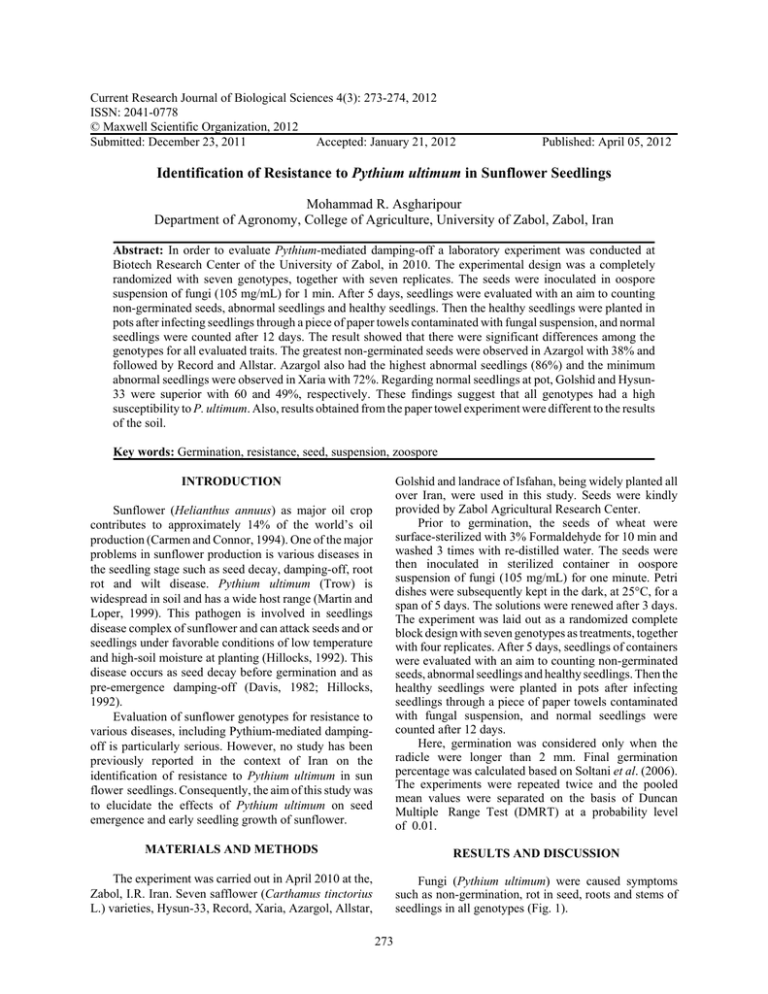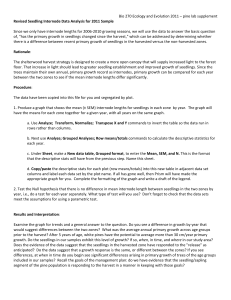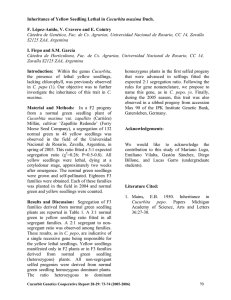Current Research Journal of Biological Sciences 4(3): 273-274, 2012 ISSN: 2041-0778
advertisement

Current Research Journal of Biological Sciences 4(3): 273-274, 2012 ISSN: 2041-0778 © Maxwell Scientific Organization, 2012 Submitted: December 23, 2011 Accepted: January 21, 2012 Published: April 05, 2012 Identification of Resistance to Pythium ultimum in Sunflower Seedlings Mohammad R. Asgharipour Department of Agronomy, College of Agriculture, University of Zabol, Zabol, Iran Abstract: In order to evaluate Pythium-mediated damping-off a laboratory experiment was conducted at Biotech Research Center of the University of Zabol, in 2010. The experimental design was a completely randomized with seven genotypes, together with seven replicates. The seeds were inoculated in oospore suspension of fungi (105 mg/mL) for 1 min. After 5 days, seedlings were evaluated with an aim to counting non-germinated seeds, abnormal seedlings and healthy seedlings. Then the healthy seedlings were planted in pots after infecting seedlings through a piece of paper towels contaminated with fungal suspension, and normal seedlings were counted after 12 days. The result showed that there were significant differences among the genotypes for all evaluated traits. The greatest non-germinated seeds were observed in Azargol with 38% and followed by Record and Allstar. Azargol also had the highest abnormal seedlings (86%) and the minimum abnormal seedlings were observed in Xaria with 72%. Regarding normal seedlings at pot, Golshid and Hysun33 were superior with 60 and 49%, respectively. These findings suggest that all genotypes had a high susceptibility to P. ultimum. Also, results obtained from the paper towel experiment were different to the results of the soil. Key words: Germination, resistance, seed, suspension, zoospore Sunflower (Helianthus annuus) as major oil crop contributes to approximately 14% of the world’s oil production (Carmen and Connor, 1994). One of the major problems in sunflower production is various diseases in the seedling stage such as seed decay, damping-off, root rot and wilt disease. Pythium ultimum (Trow) is widespread in soil and has a wide host range (Martin and Loper, 1999). This pathogen is involved in seedlings disease complex of sunflower and can attack seeds and or seedlings under favorable conditions of low temperature and high-soil moisture at planting (Hillocks, 1992). This disease occurs as seed decay before germination and as pre-emergence damping-off (Davis, 1982; Hillocks, 1992). Evaluation of sunflower genotypes for resistance to various diseases, including Pythium-mediated dampingoff is particularly serious. However, no study has been previously reported in the context of Iran on the identification of resistance to Pythium ultimum in sun flower seedlings. Consequently, the aim of this study was to elucidate the effects of Pythium ultimum on seed emergence and early seedling growth of sunflower. Golshid and landrace of Isfahan, being widely planted all over Iran, were used in this study. Seeds were kindly provided by Zabol Agricultural Research Center. Prior to germination, the seeds of wheat were surface-sterilized with 3% Formaldehyde for 10 min and washed 3 times with re-distilled water. The seeds were then inoculated in sterilized container in oospore suspension of fungi (105 mg/mL) for one minute. Petri dishes were subsequently kept in the dark, at 25°C, for a span of 5 days. The solutions were renewed after 3 days. The experiment was laid out as a randomized complete block design with seven genotypes as treatments, together with four replicates. After 5 days, seedlings of containers were evaluated with an aim to counting non-germinated seeds, abnormal seedlings and healthy seedlings. Then the healthy seedlings were planted in pots after infecting seedlings through a piece of paper towels contaminated with fungal suspension, and normal seedlings were counted after 12 days. Here, germination was considered only when the radicle were longer than 2 mm. Final germination percentage was calculated based on Soltani et al. (2006). The experiments were repeated twice and the pooled mean values were separated on the basis of Duncan Multiple Range Test (DMRT) at a probability level of 0.01. MATERIALS AND METHODS RESULTS AND DISCUSSION The experiment was carried out in April 2010 at the, Zabol, I.R. Iran. Seven safflower (Carthamus tinctorius L.) varieties, Hysun-33, Record, Xaria, Azargol, Allstar, Fungi (Pythium ultimum) were caused symptoms such as non-germination, rot in seed, roots and stems of seedlings in all genotypes (Fig. 1). INTRODUCTION 273 Curr. Res. J. Biol. Sci., 4(3): 273-274, 2012 CONCLUSION In conclusion, we have shown that statistically significant differences have been found to exist between the genotypes for all traits. Nevertheless, all genotypes had a high susceptibility to P. ultimum. Genotypes susceptibility to the pathogenic fungi differed between inoculation in oospore suspension and planting seedlings pots after infecting seedlings through a piece of paper towels contaminated with fungal suspension. ACKNOWLEDGMENT Percentage of normal seedings Fig.1: Non-germinated seeds, normal seedlings and infested seedlings by P. ultimum of sun flower 60 50 a a 40 30 This work has been supported by grant from University of Zabol. The author gratefully appreciates Ms. Khaje for his technical assistance and providing essential facilities during the studies. b c c d 20 REFERENCES d Abelardo, J.V., I.H. DeLacy and S.C. Chapman, 2007. Progress over 20 years of sunflower breeding in central Argentina. Field Crop Res., 100(1): 61-72. Carmen, G.D.J. and F.R. Connor, 1994. Canopy development, photosynthesis and radiation-use efficiency in sunflower in response to nitrogen. Field Crop Res., 38(1): 15-27. Davis, R.G., 1982. Relationships between seed-borne microorganisms and cotton seedling emergence. Mississippi Agric. For. Exp. Sta. Res. Rep., 7: 3. Debaeke, P. and A. Estragnat, 2003. A simple model to interpret the effects of sunflower crop management on the occurrence and severity of a major fungal disease: Phomopsis stem canker. Field Crop Res., 83(2): 139-155. Hillocks, R.J., 1992. Seedling Diseases. In: Hillocks, R.J., (Ed.), Cotton Diseases. CAB International, Wallingford, Oxon, UK, pp: 1-17. Martin, F.N. and J.E. Loper, 1999. Soil-borne plant diseases caused by Pythium spp.: Ecology, epidemiology and prospects for biological control. Plant Sci., 18: 111-118. Sadras, V.O., N. Trápani, V.R. Pereyra, M.L. Pereira, F. Quiroz and M. Mortarini, 2000. Intraspecific competition and fungal diseases as sources of variation in sunflower yield. Field Crop Res., 67(1): 51-58. Soltani, A., M. Gholipoor and E. Zeinali, 2006. Seed reserve utilization and seedling growth of wheat as affected by drought and salinity. Environ. Exper. Bot., 45: 195-200. 10 Go lsh id La nd Isf race aha of n Verities Al lst ar Az arg ol Xa ria Re co rd Hy sun -33 0 Fig. 2: Normal seedlings percentage of sunflower in a pot experiment after 12 days Analysis of variance revealed that all traits significantly changed between different genotypes. Sunflower genetic variation in response to fungal disease has been reported by Debaeke and Estragnat (2003), Sadras et al. (2000) and Abelardo et al. (2007). The greatest non-germinated seeds were observed in Azargol with 38% and followed by Record and Allstar, while Xaria and Golshid had the least non-germinated seeds (data not provided). Among the assessed genotypes, Azargol also had the highest abnormal seedlings (86%) and the minimum abnormal seedlings were observed in Xaria with 72%. Other varieties were between these two varieties (data not provided). Xaria with the highest normal seedlings and the least abnormal seedlings was the most resistant genotypes in response to P. ultimum at germination stage. Lowest number of non-germinated seeds was observed at landrace of Isfahan (data not provided). The percentages of normal seedling as affected by the different genotypes at pot experiment are presented in Fig. 2. Golshid showed more resistant than other genotypes at pot culture and followed by Hysun-33. Results obtained from the paper towel experiment were different to the results of the soil. The results also showed that most genotypes are highly sensitive to the P. ultimum (Fig. 2). 274




